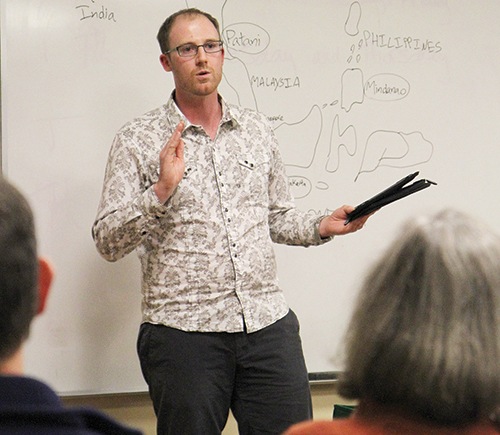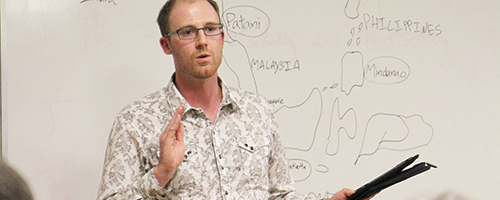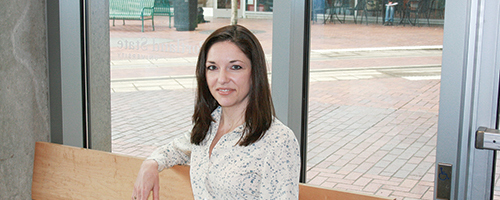While religion has played a major role in a vast number of wars and conflicts over the years, have you ever stopped to wonder what makes one war holier than another? Dr. Shane Barter of Soka University of America did.
How holy is this holy war?

While religion has played a major role in a vast number of wars and conflicts over the years, have you ever stopped to wonder what makes one war holier than another?
Dr. Shane Barter of Soka University of America did.
On Wednesday, Barter and SUA student Ian Osburn presented their paper, titled “Shrouded: Islam, War and Holy War in Southeast Asia,” in a lecture sponsored by Portland State’s Institute for Asian Studies.
The two conducted field research in the Muslim communities of Aceh, Indonesia; Pattani, Thailand; and Mindanao in the Philippines.
Rather than finding the answer in texts, history or from the word of a militant leader, as many scholars might, Barter believes that by looking at four distinct aspects of a conflict one can have a better understanding of the role religion plays.
The four facets Barter considers are: what type of people make up the rebel leaders, how people are recruited, community sentiment about the conflict and, most importantly, how the community handles burial practices.
When first trying to understand what makes one war more religious than another, Barter found flaws in several of the most commonly used approaches.
He noted that many scholars look to texts, citing the Quran as an example. He said that the age of the text alone makes it so that the Quran “can’t be used to support claims in contemporary society.” Barter also said that looking to history for an answer to what makes one war more religious than another holds the same flaws as looking to texts.
Another method that seemed both inefficient and inaccurate to Barter was quoting militant or rebel leaders’ opinions on the role of religion in a conflict.
“We can’t trust the bin Ladens of the world and what they say,” Barter said, explaining that religion is often used manipulatively in conflicts to recruit more followers or as propaganda.
Instead, Barter spent his time in Aceh, Mindanao and Pattani pursuing a more appropriate course of study by asking and observing within the communities.
To understand Barter’s findings better, it is best to know a bit about the three regions he studied. In all three there is a secessionist conflict as well as a Muslim minority. However, that’s where the similarities end.
Aceh, a region in Indonesia with a population of 4.5 million people, was under the Suharto regime, which conducted shock therapy and torture to captured rebels until 1999, when the regime ended. The war for a free Aceh continued, however, until 2005. The conflict in Aceh, Barter explained, was more about human rights abuse than religion.
Unlike in Aceh, the roots of the conflicts in Mindanao and Pattani are more religious, Barter said.
Mindanao is the second-largest and easternmost island in the Philippines, and the only area with a significant Muslim presence. Widespread poverty, the transmigration of Christian settlers and religious conflict have lead to the separatist movement.
Pattani is a region in southern Thailand made up of several provinces. In Pattani, the separatist movement is made up of rebel groups, some good and others corrupt, seeking to create a Malay Islamic state; the movement has resulted in violence.
The first step Barter took in trying to assess the role of religion in each conflict was to look at rebel leaders. Not at what they say, he explained, but at what type of people they are. In Aceh, the leaders were mostly businessmen with Western educations who had lived in the United States.
“However, in Pattani and Mindanao, while many of the rebel leaders were well-educated, the networking system was Islamic,” Barter said.
Next, Barter studied the recruitment styles of the rebel groups. He noted that in Aceh, the members of the rebel groups joined most often for personal reasons, or because they were victims of the violent Suharto regime.
In Pattani and in Mindanao, however, “rebel members were recruited through mosques and Islamic boarding schools—young men who were kept from society,” he explained.
Barter also felt it important to speak with members of the community and get their input on the conflicts. He noted that while surveying people was not exactly the most realistic approach, it was possible to understand the community’s opinion better through observation.
For example, the difference in music was very telling. In Aceh, the music has very traditional Islamic sounds to it, but the lyrics are highly ethnonational in content. On the other hand, in Pattani and Mindanao the music had a pop sound but the lyrics were very religious, with words such as, “God came down and protected a rebel leader.”
For Barter, the burial treatment of dead rebels was the most telling of all.
In Aceh, where the militia would mutilate and publicly display the bodies of dead rebels, Islamic leaders would risk their lives to take the bodies and give them a proper burial, Barter said. The dead were seen as martyrs for the nation, rather than for Islam, he said.
In Mindanao and Pattani, where the most common attacks are suicide bombings, there is a very distinct role that Islam plays in motivating martyrs. In these regions, the bodies of the dead martyrs are left in the street, covered with wax and sprayed with the scent of roses to provide the illusion that the body is not decomposing.
His findings led him to believe that religion played a larger role in the conflicts in Mindanao and Pattani than in Aceh.
Through these methods, Barter believes it is possible to more accurately assess the role religion plays in a conflict. He hopes that his approach will lead to more careful and correct opinions on conflicts around the world, explaining that not all holy wars are so holy.
“Chances are,” he said, “they are somewhere in between.”





